#spiritual heritage of Hinduism
Text
Unlocking Divine Union: The Significance and Spiritual Benefits of Ark Vivah Puja
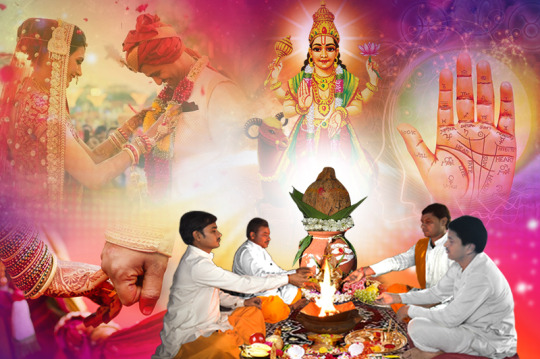
Introduction:
In the realm of Hindu spirituality, rituals and ceremonies hold a profound significance. These practices are not just traditions; they are bridges connecting mortal souls to the divine. One such sacred ritual is the Ark Vivah Puja, a ceremony that signifies a unique and spiritual union. In this blog, we delve into the depths of Ark Vivah Puja, exploring its significance, the power of mantras, and the spiritual benefits it bestows upon devotees.
Understanding Ark Vivah Puja:
Ark Vivah Puja, also known as "Tulsi Vivah," is a ceremonial marriage between the holy basil plant (Tulsi) and the deity Lord Vishnu or his incarnation Lord Krishna. This ritual is usually performed on the Ekadashi tithi (11th day) of the waxing moon in the month of Kartik (October–November). The ceremony marks the symbolic wedding of the divine and the sacred Tulsi plant, which holds immense spiritual importance in Hindu culture.
The Mantra and its Power:
Mantras are powerful vibrations that connect practitioners to higher realms of consciousness. During the Ark Vivah Puja, specific mantras are chanted to invoke the blessings of Lord Vishnu and Tulsi Devi. One of the most revered mantras is the "Shri Krishna Tulsi Mantra," which is recited to seek divine harmony and blessings in the union. Chanting this mantra not only purifies the surroundings but also uplifts the spirits of those participating.
Significance of Ark Vivah Puja:
The Ark Vivah Puja holds multifaceted significance:
Spiritual Union: The marriage of Tulsi and Lord Vishnu symbolizes the harmonious union of the divine feminine and masculine energies. This represents the cosmic balance and the interconnectedness of all creation.
Blessings of Lord Vishnu: Lord Vishnu is considered the preserver of the universe. By participating in the Ark Vivah Puja, devotees seek his divine blessings for a prosperous and protected life.
Purification: The Tulsi plant is renowned for its purifying properties. Its presence in homes is believed to cleanse the surroundings and ward off negative energies. Through this ritual, devotees aim to purify their inner and outer environments.
Health and Longevity: The leaves of the Tulsi plant hold medicinal value. Performing the puja is believed to promote good health and longevity.
Kartik Ekadashi: The day of the Ark Vivah Puja falls on Kartik Ekadashi, a highly auspicious day for spiritual practices. Participating in this puja on this day amplifies its significance and benefits.
Spiritual Benefits of Ark Vivah Puja:
Engaging in the Ark Vivah Puja offers profound spiritual benefits:
Inner Harmony: The puja promotes inner harmony and balance by invoking the energies of divine union.
Purification of Mind: Chanting mantras and performing rituals cleanses the mind of impurities, fostering clarity and spiritual growth.
Divine Protection: Seeking blessings from Lord Vishnu through this puja establishes a protective shield around devotees, guarding them from adversities.
Cultural Reverence: Participating in such rituals helps preserve and honor the rich cultural and spiritual heritage of Hinduism.
Connection with Nature: The Tulsi plant symbolizes nature's sacredness. Engaging with it in this ritual fosters a deeper connection with the natural world.
Ark Vivah Puja by Astro Pragyan:
At Astro Pragyan, we understand the profound impact of Vedic rituals on spiritual well-being. Our experienced priests perform the Ark Vivah Puja with meticulous adherence to traditions and rituals. Through this sacred ceremony, we aim to guide devotees toward spiritual elevation and a deeper connection with the divine.
Book this Ark Vivah Puja:
Ready to embark on a journey of spiritual union and growth? Book your Ark Vivah Puja with Astro Pragyan today. Allow us to guide you through this sacred ceremony and help you reap its spiritual benefits.
Conclusion:The Ark Vivah Puja stands as a testament to the divine mysteries woven into Hindu traditions. With its rich symbolism, mantras, and spiritual benefits, it offers a profound opportunity for devotees to connect with the divine and transform their lives. As you embark on this journey of spiritual union, let the Ark Vivah Puja illuminate your path with blessings, harmony, and enlightenment.
#Hindu culture#Ark Vivah Puja#Vedic rituals#spiritual heritage of Hinduism#Kartik Ekadashi#astronomy#astrology#spirituality#motivation
0 notes
Text
श्री रामचन्द्र कृपालु भजु मन हरण भवभय दारुणम्।
नवकंज लोचन, कंजमुख कर कंजपद कंजारुणम्॥
O mind, worship Lord Shri Ramachandra, the compassionate one, who removes all fears and sorrows of existence. His eyes are like lotus petals, His face is as beautiful as a lotus flower, and His hands are adorned with lotus-like fingers

Sustaining and Spreading Essence of Ayodhya with every Sanatani and Ram Devotees Worldwide
#inspirational quotes#ayodhya#ayodharammandir#ram mandir#bharat#jai shree ram#ramayana#lord rama#essence#heritage#culture#hinduism#spiritual journey#spirituality#sanatandharma#hindu mythology
2 notes
·
View notes
Text
#Ram Lalla#Ram Mandir#Ayodhya#Lord Ram#Hinduism#Divine Child#Spirituality#Temple Construction#FaithIn Ram#Cultural Heritage#Religious Harmony#Pilgrimage#SacredIdol#Ramayana#Divine Blessings#Ayodhya Land Dispute#Supreme Court Verdict#Hindu Tradition#Religious Unity
0 notes
Text
The History and Significance of Hindu Festivals: A Celebration of Tradition and Spirituality
Hindu festivals are vibrant and joyous occasions that hold immense historical and cultural significance. They are celebrated throughout the year, each with its own unique customs, rituals, and stories. These festivals not only bring communities together but also provide an opportunity to delve into the rich tapestry of Hindu mythology, values, and spiritual beliefs. In this blog post, we will…
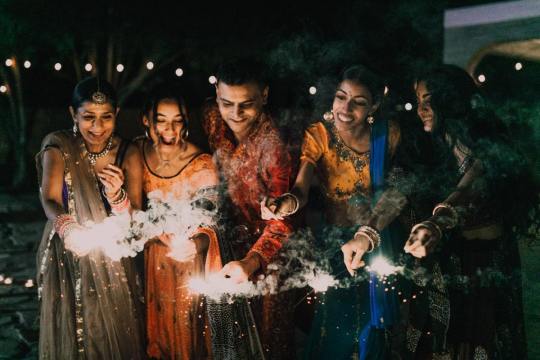
View On WordPress
#Celebration#Culture#devotion#Diwali#Durga Puja#Family#Ganesh Chaturthi#harmony#Heritage#Hindu festivals#Hinduism#Holi#Joy#Navaratri#Raksha Bandhan#Society#Spiritual essence#spirituality#tradition#Unity
0 notes
Text
#Hinduism#Janeu ceremony#Upanayana#sacred thread#Vedic learning#Brahmin caste#spiritual significance#three debts#purifying bath#guru#mantras#feast#passing of knowledge#cultural heritage.#your spiritual journey
0 notes
Text
#Akshardham Temple Delhi#Hinduism#Cultural Heritage#Architecture#Sculptures#Paintings#Spiritual Learning#Yoga#Meditation#Vegetarian Restaurant#Environmental Sustainability#Community Service#Indian Culture#Indian Art#Renewable Energy#Water Conservation#Classical Music#Dance Performances#Traditional Festivals.
1 note
·
View note
Text
So, Why Violet? The Short of It

Now if you've seen Riku across this series, you'll notice a recurring theme with him is the purple, or as I'll call it here...the violet. Why I call it specifically violet is because violet is not simply just a color or a combination of red and blue but actually exists on the visible light spectrum.

At the shortest wavelength of all light, it also has the highest energy. And beyond the visible spectrum exists a little something called ultraviolet. Ultraviolet (UV) light is a form of light only naturally found in sunlight.

Riku is often represented by the sun and sunlight so it's incredibly fitting that his heart light color would be closely related to it. And the real kicker is that ultraviolet is usually INVISIBLE to the human eye.








Also did you notice how they say seven pure hearts of light? Well, there's seven lights on the visible light spectrum.
Now for some color symbolism!
In Hinduism, violet is the color used to represent the Sahasrara, also known as the "crown" chakra. It is the point of which all other chakras originate and relates to pure consciousness. For Sora to reach full consciousness is a GIANT underlying theme in KH and it heavily involves his relationship with Riku.
The violet flower represents everlasting love and humility. It was the flower that Persephone was gathering when she was taken by Hades to the Underworld. They are flowers of transformation, the cycle of life and death, and rebirth.
Riku's light has guided Sora to the Final World and back, acting as the in-between of life and death for him. His connection to Sora is what brings Sora to the Dark World in KH3 through the Power of Waking and Riku has plunged into the KH lore equivalent to an Underworld to bring Sora back to life and home.
Because of the expensive nature of its dyes, violet is commonly associated with royalty and nobility as only the most wealthy could afford it. Riku has been theorized to have noble heritage and has found himself a great leader to those around him.
Other meanings behind this color include: the future, dreams, enlightenment, balance, a link between the spiritual and physical worlds, wisdom, and remembrance. All very fitting!
So as you can see, there's a pretty damn good basis for violet being Riku's heart color.
58 notes
·
View notes
Note
It's a shame fans ignore Hari Bulkan. It's very clearly a nod to Dante Basco's Filipino heritage and a way of keeping that significance alive since most of the ATLA voice actors were white instead of Asian. Although the word "Bulcan" itself comes from the influence of Spanish colonization (I cannot emphasize how horrific that colonization was and continues to be horrific on our culture; they burned everything to the point my own parents didn't know we had our own writing system, a pantheon of gods, and the fact the word "bahala" [a word Filipinos use at least once a day] comes from the name Bathala, our creator god). Hari Bundok would have been more accurate in the sense that pre-colonial Filipinos' word for mountains and volcanos are the same since, being a nation of over 7000 islands, most mountains ARE volcanos and there was no need for that distinction because we were the inhabitants.
Hari does mean king or monarch in Tagalog, but (coincidentally [?]) is also one of the names of the Hindu deity Vishnu. I say coincidentally[?] because the pre-colonial Philippines was a major trading point and essential "pit-stop" en route. Our pre-colonial writing system, Baybayin, is a brahmic script, meaning it a descendant of the Brahmi script of ancient India!
And of course, Agni is a Hindu deity. Agni lost prominence in the later/post Vedic Era, but scholars believe they were foundational to creator-preserver-destroyer thought in Hinduism, which is also significant when looking at Zuko's personal and spiritual journey and a wielder of fire.
I bring all this up not only because of representation in ATLA and ATLA fandom, but also because of the negative "social hierachry" treatment India and Southeast Asia experiences within greater Asia. We are browner, considered inferior, less beautiful, less culturally sophisticated, and have experienced a history of violent colonism more frequently, and sometimes beneath the heel of, our East and Northeast Asian cousins. For anyone with Indian or Southeast Asian heritage, that common feeling was named by comedian Ali Wong who distinguished between "fancy Asians" versus "jungle Asians"
That was really informative! Thank you for taking the time to share this with me!
132 notes
·
View notes
Text
Temples in varanasi | Exploring the Spiritual Heart of India
Temples in varanasi not merely places of worship but embodiments of profound spirituality and cultural heritage. The city's ancient holiness makes it a sacred geography in Hinduism. The mystical beauty of Varanasi's temples transcends the physical realm, offering a profound spiritual experience that lingers long after you have left this ancient city, As you wander through the sacred city's ancient streets, you'll encounter a divine realm that transcends time, leaving an everlasting imprint on your soul.

#temple#tulsi manas temple#temples#kashi vishwanath temple#temples in varanasi#ram mandir#har har mahadev#manikarnika ghat#hanuman mandir#manikarnika#hotels in varanasi#vaksinasi#vacation#varanasighats#bajrangbali
8 notes
·
View notes
Text
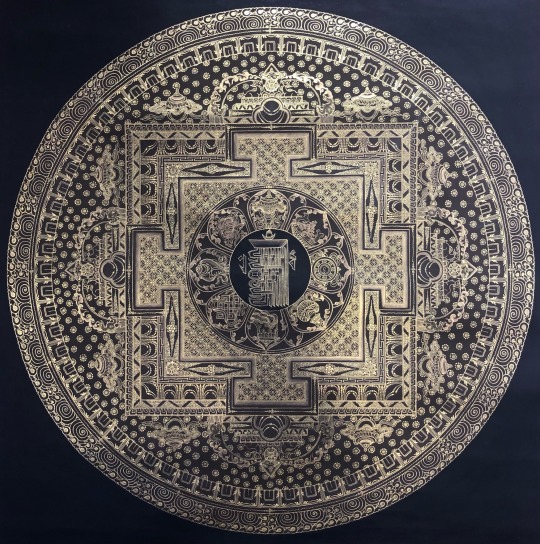
Mandalas are powerful spiritual symbols used in ceremonial rituals, worship and meditation. They are used by both Hindus and Buddhists to represent universe. In Hinduism and Buddhism, the belief is that by entering the mandala and proceeding towards its center, one are guided through the cosmic process of transforming the universe from one of suffering into one of joy and happiness. Mandalas are intended to deliver wisdom, evoke feelings of calm, and channel focus and concentration.
.
.
.
.
.
#Symbol #spiritual #sacred #circle #universe #mandala #meditation #healing #compassion #wisdom #hinduism #buddhism #tibetan #art #himalayan #thangka #lamathankapaintingschool #thankapainting #himalayanart #livingheritage #heritage #compassion #kalachakra #tantra #mindfullness
62 notes
·
View notes
Text

The Symbolic Value of the Lotus in Asian Culture
Symbols are mental images that by convention play a profound role in shaping cultures and their identities. They contain within themselves a neural nexus that has been stamped by the amygdala as being numinous. A collective, awe, develops around certain symbols that hold significant meaning and the lotus flower stands out as one of the most revered and cherished symbols in Asian culture.
When the divinity contained in the life substance is about to put forth the universe, the cosmic waters grow a thousand-petaled lotus of pure gold, radiant as the sun. This is the door or gate, the opening or mouth, of the womb of the universe. It is the first product of the creative waters, the material unconscious, corruptible in the particular, but now gold as incorruptible nature in totality. It opens to give birth first to the demiurge-creator, Brahmã, or further West, Yaldabaoth. From its pericarp then issue the hosts of the created world. This is the procreative aspect of the Absolute, and the cosmic lotus is its generative organ. The cosmic lotus is the highest form or aspect of Earth. It is personified as the Mother Goddess through whom the Absolute moves into creation.
Found across various countries and religions, the lotus has captivated the hearts and minds of people for centuries and the lotus holds immense spiritual symbolism in Asian cultures, particularly in religions such as Hinduism, Buddhism, and Jainism. In Hinduism, the lotus is associated with deities like Lakshmi, the goddess of wealth and prosperity, and Saraswati, the goddess of knowledge and arts. It represents purity, enlightenment, and divine beauty. Similarly, in Buddhism, the lotus is a central symbol that embodies purity, spiritual growth, and enlightenment. The lotus flower's ability to emerge gracefully from muddy waters, pristine and untouched, symbolizes the journey from ignorance to enlightenment.
The lotus has inspired countless artistic expressions throughout Asian history. From ancient sculptures to traditional paintings, the lotus is a recurring motif in Asian art. It is often depicted in various forms, such as blooming, bud, or seedpod, each carrying its own symbolic meaning. The delicate petals and vibrant colors of the lotus have been captured in intricate details, conveying a sense of elegance, grace, and purity. The lotus is not only a subject of artistic representation but also serves as a source of inspiration for artists, poets, and writers, evoking emotions of tranquility and serenity.
The lotus also holds deep philosophical significance in Asian cultures, representing the path to spiritual enlightenment and personal growth. In Buddhism, the concept of "lotus sutra" emphasizes the idea that all beings, regardless of their circumstances or origins, have the potential to attain enlightenment. The lotus serves as a metaphor for the human soul's journey towards self-realization, transcending the worldly attachments and reaching a state of enlightenment. Its ability to rise above the murky waters symbolizes the triumph of the human spirit over adversity and challenges.
Beyond its spiritual and philosophical connotations, the lotus has become an integral part of Asian cultural identity. It is a symbol of national pride, representing purity, beauty, and resilience. In countries such as India, China, Japan, and Vietnam, the lotus is closely associated with their cultural heritage. In festivals, rituals, and ceremonies, the lotus is often featured as a decorative element, signifying auspiciousness, prosperity, and good fortune.
The lotus in mind stands as a testament to the enduring power of symbolism in shaping cultural narratives and fostering a profound connection between humanity, the natural world, and search for meaning outside the empirical world.
10 notes
·
View notes
Text
culture of India
India, often referred to as the land of diversity, is a cultural kaleidoscope that has fascinated and enchanted people from across the globe for centuries. Its rich heritage, traditions, languages, art forms, and cuisines reflect a civilization that has evolved over millennia, leaving an indelible mark on the world. In this blog, we embark on a journey to unravel the multifaceted culture ,culture of India delving into its historical roots, religious practices, artistic expressions, and modern-day manifestations.

Historical Background:
The cultural history of India can be traced back to ancient times, with evidence of human habitation dating back to the Stone Age. The subcontinent has witnessed the rise and fall of numerous civilizations, including the Indus Valley Civilization, which flourished around 3300 BCE. Subsequent waves of migration and settlement by various ethnic groups, including Aryans, Dravidians, Greeks, Persians, and Mongols, contributed to the diversity of India's cultural landscape.
Religious Diversity:
India is the birthplace of major religions such as Hinduism, Buddhism, Jainism, and Sikhism, and has also been a melting pot of diverse faiths, including Islam, Christianity, Judaism, and Zoroastrianism. The religious tolerance and syncretism prevalent in India have resulted in a vibrant tapestry of rituals, festivals, and spiritual practices that coexist harmoniously. From the grand celebrations of Diwali and Eid to the solemnity of Buddhist retreats and Sikh gurdwaras, religion permeates every aspect of Indian life, shaping its customs, beliefs, and social structures.
Art and Architecture:
Indian art and architecture are renowned for their intricacy, symbolism, and spiritual significance. The ancient rock-cut temples of Ajanta and Ellora, the majestic forts and palaces of Rajasthan, and the exquisite carvings of temples in Khajuraho are testaments to India's rich architectural heritage. The country's artistic traditions encompass a wide array of mediums, including painting, sculpture, pottery, textiles, and performing arts such as dance, music, and theater. Classical dance forms like Bharatanatyam, Kathak, Odissi, and Kuchipudi, with their roots in mythology and spirituality, continue to captivate audiences worldwide with their grace and elegance.
Cuisien:
Indian cuisine is as diverse as its culture, with each region boasting its own unique flavors, ingredients, and cooking techniques. From the fiery curries of the south to the aromatic biryanis of the north, Indian food is a gastronomic delight that tantalizes the taste buds with its rich spices and bold flavors. Staples like rice, wheat, lentils, and vegetables form the foundation of Indian meals, which are often accompanied by chutneys, pickles, and dairy products like yogurt and paneer. Street food is also a ubiquitous part of Indian culinary
culture, offering a tantalizing array of snacks and sweets that cater to every palate.
Literature and Language:
India has a rich literary tradition dating back thousands of years, with ancient texts like the Vedas, Upanishads, and epics like the Ramayana and Mahabharata shaping the cultural consciousness of the nation. Sanskrit, the classical language of ancient India, has been the vehicle for some of the world's most profound philosophical and literary works. Over the centuries, regional languages like Tamil, Telugu, Kannada, Bengali, Marathi, Gujarati, and Punjabi have flourished, producing a wealth of literature in poetry, prose, and drama. The Indian diaspora has also made significant contributions to world literature, with writers like Salman Rushdie, Arundhati Roy, and Jhumpa Lahiri garnering international acclaim for their works.
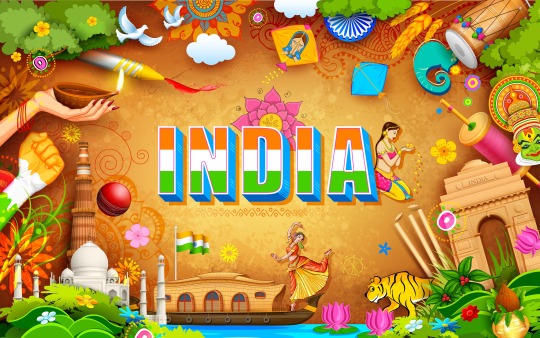
Modern Cultural Expressions:
While India's cultural heritage is deeply rooted in tradition and history, it is also a dynamic and evolving entity that continues to adapt and innovate in response to changing times. The advent of globalization, urbanization, and technology has ushered in new forms of cultural expression, from Bollywood films and indie music to contemporary art and fashion. Social media platforms like Instagram and YouTube have provided a platform for young Indian artists, musicians, and influencers to showcase their talents and connect with audiences around the world. Despite the challenges of modernization, India remains proud of its cultural heritage, embracing both tradition and innovation in equal measure.
Conclusion: India's cultural tapestry is a testament to the resilience, creativity, and diversity of its people. Across the length and breadth of the subcontinent, from the snow-capped Himalayas to the sun-drenched beaches of Kerala, the spirit of India's cultural heritage continues to thrive, enriching the lives of millions and inspiring generations to come. As we celebrate the vibrant mosaic of traditions, languages, and customs that make up the fabric of Indian society, let us also recognize the importance of preserving and safeguarding this invaluable legacy for future generations to cherish and embrace.
2 notes
·
View notes
Text
HINDU TEMPLES:
Mysteries of Hindu temples:
Secret passages and chambers: Many Hindu temples have secret passages and chambers that are believed to be used by priests and devotees for meditation and spiritual practices. Some of these passages are hidden and only known to a select few.
Hidden meanings in sculptures and carvings: Hindu temples are known for their intricate sculptures and carvings, which often have hidden meanings and symbolism related to Hindu mythology and spirituality. These meanings are often known only to scholars and experts.
Healing powers: Many Hindu temples are believed to have healing powers. Devotees visit these temples to seek relief from physical and mental ailments, and it is believed that the positive energy and vibrations of these places can help in healing.
Energized idols: The idols in Hindu temples are believed to be energized with spiritual energy through various rituals and practices. It is believed that the energy emanating from these idols can help in spiritual growth and transformation.
Ancient engineering techniques: The construction of Hindu temples is often a marvel of ancient engineering techniques. The use of stones, pillars, and domes, as well as the intricate designs and carvings, are a testament to the advanced skills of ancient Indian architects and craftsmen.
Cosmic alignment: Some Hindu temples are believed to be built in alignment with cosmic energies and celestial bodies. The positioning of the temple, the orientation of the idols, and the design of the structure are all believed to be in tune with cosmic vibrations.
Sacred geometry: The design and layout of Hindu temples are often based on sacred geometry. The shapes and proportions used in the construction of the temple are believed to have spiritual significance and create a harmonious space for worship and meditation.
Vedic knowledge: Hindu temples are often centers of Vedic knowledge, where spiritual practices and rituals are conducted based on ancient Vedic texts. The teachings and practices followed in these temples are based on the wisdom and knowledge of the Vedas.
Mystery of temple bells: The sound of temple bells is believed to have a spiritual significance. It is believed that the ringing of bells can create positive vibrations and energy, and can also ward off negative energies and spirits.
Divine revelations: Many devotees claim to have had divine revelations and experiences within the confines of Hindu temples. These experiences are often deeply personal and transformative, and can range from visions of deities to profound insights into the nature of reality.
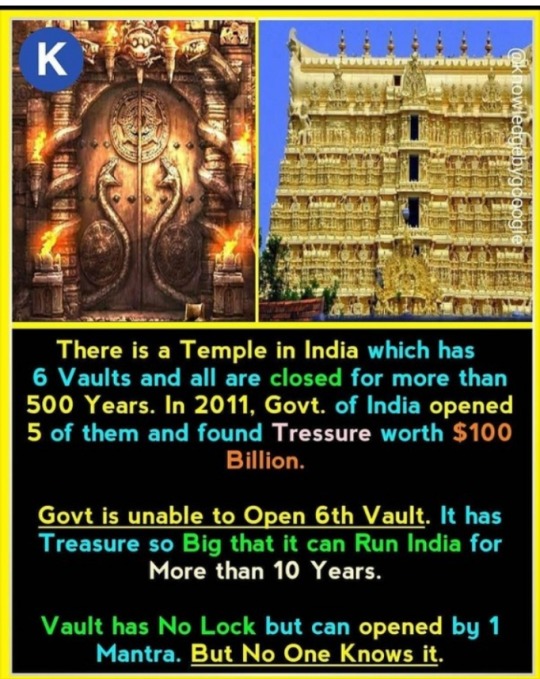
Significance of hindu temples:
Place of worship: Hindu temples are primarily places of worship where devotees can offer prayers and perform various rituals and practices to connect with the divine.
Spiritual growth: Hindu temples are also places for spiritual growth and transformation. Devotees can participate in various spiritual practices and learn from the teachings of the Hindu scriptures.
Community center: Hindu temples are often centers of the local Hindu community, where members can come together to celebrate festivals, cultural events, and other social activities.
Cultural significance: Hindu temples are important cultural landmarks and symbols of the rich cultural heritage of India. They showcase the unique architecture, art, and traditions of the Hindu culture.
Educational institutions: Many Hindu temples also function as educational institutions, where students can learn about Hindu philosophy, spirituality, and culture.
Charity and social welfare: Hindu temples often engage in various charity and social welfare activities, such as feeding the poor, providing healthcare, and supporting education.
Preservation of traditions: Hindu temples play an important role in preserving and passing on the traditions and practices of Hinduism to future generations.
Pilgrimage centers: Many Hindu temples are pilgrimage centers, where devotees can seek blessings and perform various rituals and practices to fulfill their spiritual goals.
Healing centers: Some Hindu temples are believed to have healing powers and are visited by devotees seeking relief from physical and mental ailments.
Universal appeal: Hindu temples have a universal appeal and attract devotees from all walks of life, religions, and cultures, who come to experience the spiritual and cultural richness of Hinduism.

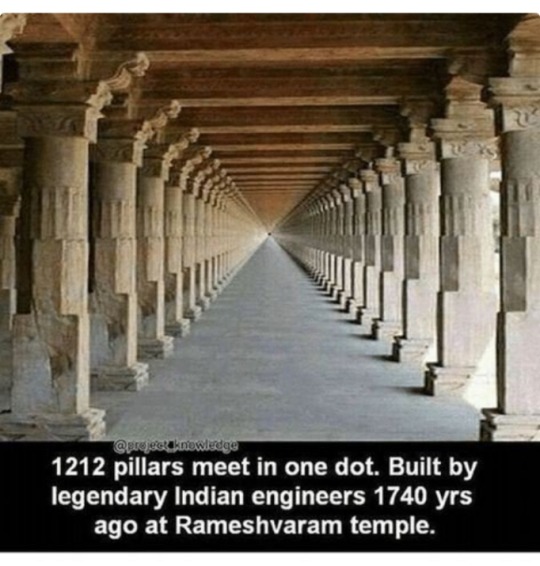
For Shopping:
Click Here
Click Here
15 notes
·
View notes
Text
#Ram Lalla#Ram Mandir#Ayodhya#Lord Ram#Hinduism#Divine Child#Spirituality#Temple Construction#FaithIn Ram#Cultural Heritage#Religious Harmony#Pilgrimage#SacredIdol#Ramayana#Divine Blessings#Ayodhya Land Dispute#Supreme Court Verdict#Hindu Tradition#Religious Unity
0 notes
Text
Island Paradise: The Serene Beauty of Bali, Indonesia
Bali, the "Island of the Gods," is a true paradise on Earth. With its stunning landscapes, vibrant culture, and warm hospitality, it has captured the hearts of travellers from around the globe. Nestled in the Indonesian archipelago, Bali offers a serene and enchanting experience that is unlike any other. From pristine beaches and lush rice terraces to ancient temples and vibrant markets, this tropical haven has something for everyone. Join us on a journey as we explore the serene beauty of Bali, immersing ourselves in its natural wonders, cultural treasures, and soul-soothing experiences.
Enchanting Beaches and Crystal-clear Waters
Bali is renowned for its breathtaking beaches that stretch along its coastline. From popular destinations like Kuta and Seminyak to hidden gems like Nusa Dua and Sanur, each beach offers its own unique charm. Picture-perfect white sands, swaying palm trees, and azure waters create a postcard-worthy scene. Whether you're looking to relax under the sun, surf the waves, or indulge in exhilarating water sports like snorkelling and diving, Bali's beaches cater to every preference. A visit to the stunning beaches of Bali is a must for any traveller seeking tranquillity and natural beauty.
Ubud: The Cultural Heart of Bali
Located amidst lush greenery and terraced rice fields, Ubud is the cultural heart of Bali. This charming town is a haven for art enthusiasts, yoga practitioners, and seekers of spiritual enlightenment. Explore the vibrant local markets where you'll find unique handicrafts, textiles, and traditional artworks. Visit the magnificent Ubud Palace and witness captivating Balinese dance performances. Immerse yourself in the tranquillity of the Ubud Monkey Forest, where cheeky macaques roam freely amidst ancient temples. For a transformative experience, participate in a yoga or meditation retreat that will rejuvenate your mind, body, and soul. Ubud is a place where creativity, spirituality, and natural beauty converge.
Temples: A Glimpse into Balinese Spirituality
Bali is known for its countless temples, each with its own story and significance. The island's spiritual essence is deeply rooted in Hinduism, and the temples provide a glimpse into Balinese religious and cultural practices. The iconic Tanah Lot temple, perched on a rock formation by the sea, is a sight to behold, especially during sunset. Uluwatu Temple, located on a cliff with stunning ocean views, is not only a place of worship but also a venue for mesmerising Kecak dance performances. Besakih Temple, known as the "Mother Temple," is the largest and most important Hindu temple in Bali, set against the backdrop of Mount Agung. Exploring these sacred sites allows travellers to appreciate the deep spirituality and devotion of the Balinese people.
Rice Terraces: The Green Tapestry of Bali
The iconic rice terraces of Bali are a testament to the island's agricultural heritage. The intricate system of rice cultivation, known as subak, has been practised for centuries and is recognized as a UNESCO World Heritage site. The emerald-green rice fields, with their cascading tiers, create a stunning visual spectacle. Tegalalang and Jatiluwih are two of the most famous rice terrace destinations in Bali. Take a leisurely stroll through the terraces, breathe in the fresh air, and witness the farmers at work. The rice terraces not only offer a breathtaking landscape but also provide insight into the sustainable farming practices that sustain the island's economy.
Balinese Cuisine: A Gastronomic Journey
No visit to Bali is complete without indulging in its delectable cuisine. Balinese food is a flavorful blend of spices, fresh ingredients, and cultural influences. Sample the famous Babi Guling (suckling pig), Satay, and Nasi Goreng (fried rice) at local warungs (small eateries). Immerse yourself in the unique dining experience of a traditional Balinese feast, known as a "megibung," where a variety of dishes are served on a banana leaf. Don't forget to try the refreshing and healthy Balinese specialty, Jajan Pasar (market snacks), which includes colourful and sweet treats. Bali also boasts a thriving café culture, with quaint coffee shops serving artisanal coffee and innovative dishes. Embark on a gastronomic journey that will tantalise your taste buds and leave you craving for more.
Conclusion
Bali, Indonesia's Island Paradise, offers a serene and awe-inspiring experience that captivates travellers. From its enchanting beaches and spiritual temples to its cultural hub in Ubud and breathtaking rice terraces, Bali showcases the beauty of nature, the richness of its heritage, and the warmth of its people. Whether you seek relaxation, adventure, or a spiritual retreat, Bali has it all. The island's allure lies not only in its physical beauty but also in the spiritual essence that permeates every corner. A visit to Bali is a journey of self-discovery and connection with nature and culture. So pack your bags, immerse yourself in the serene beauty of Bali, and let this island paradise weave its magic on your soul.
3 notes
·
View notes
Text
The Aspects of Knowledge and Wisdom
For a few months now, I’ve been in a weird limbo with my spirituality where I have a strong pull to something, but have been hesitating to pursue it because it feels like I’m doing something “deviant.” That no one does this. I guess I’ve been researching a good amount, but I haven’t been following up, if that makes sense.
Today I sort of took a step back, reviewed basically everything I understand, and everything I would like to look into and understand. And I realize that it doesn’t really matter if no one else does this (and to be fair, I don’t really believe that NO ONE else has thought these things or incorporated these things into their beliefs). If I feel a pull to it, I should investigate and see if it leads me somewhere. There’s no actual “pagan police” coming to arrest me if I do something different (though I think a lot of people can act like that…).
Basically, I love the God and the Goddess of Wicca as a framework to understand the Divine. I revere the Horned God and the Lady of the Moon, while recognizing that they may also have different aspects or emanations (to use a concept from Hinduism that has always stuck with me). There are different forms of the Divine (which may manifest as gods, spirits, ideas, anything really), but each of them is unique and specific for a particular place, people, culture, time, individual. Ultimately, I think I buy the whole “all spiritualities are valid” as a result. (I think it’s a metaphor in Buddhism that we are all on many paths up the mountain, but they all lead to Nirvana, or something like that…)
I also love the ritual and “formality” of Wicca because it’s much like my Catholic background, only not as formal. I don’t really feel bad and have to apologize if I misspeak a prayer, or forget what I was going to say, or all of a sudden have to get up and pee in the middle of a ritual. I just kinda laugh and try again, or say “well, I’m sure you know what I’m trying to say!”, or respectfully ask to be excused. (I think the “cutting a door in the magic circle to leave and return” is really cute for some reason.) Point being that I don’t have to feel shame. I don’t have to beg forgiveness. I apologize when I do wrong, but now I know that not every trivial misstep or harmless pleasure is a sin. My gods love me, know me, and are always patient and ready to guide me.
But despite how liberating paganism has been for me, I know that I can’t just delete my Catholic past and pretend like it never happened. It WAS an important part of my life. And it IS important to my past, my heritage, my culture and traditions. I’m not going to pretend like it has no effect whatsoever on my spirituality now, because it does. And I’m happy accepting that.
All this to say that I unexpectedly got caught up in studying Gnostic ideas and texts for a while, and even though Jesus is no longer a part of my faith (I respect and regard him much like a Bodhisattva, an enlightened individual in Buddhism who tries to help others also reach enlightenment), I still find a lot of resonance in various Gnostic ideas and themes. And from all that, I’ve also found that the school of Luciferian thought has really brought me a lot of inspiration, guidance, and peace. I feel that a Divine entity has reached out to me in the guise of Lucifer. He is and he is not the Horned God of the witches. He is and he is not a fallen angel or demon. He is and he is not a part of Christian or pagan thought.
My encounters with and feelings about him are complex. For a time, I think I mistook him for the Morrigan, as it was a god(dess) guiding me through pain and suffering, facing the dark truths about myself, and urging me to assert and fight for my truth and my agency. (Ravens were involved as well, for some reason.) But after a lot of work and reflection I decided this entity didn’t really fit her. There was softness and light and something more familiar than the Irish mythology I was only just learning about. So I respectfully honored An Morrigan and backtracked to re-examine who this was.
Maybe it was just another face of the Goddess I was already connected to? (I concluded not quite. It felt feminine sometimes but not the same kind of feminine I was already familiar with, if that makes sense.) But I also felt the call to pursue knowledge, cast out my old doubts and guilt, and not be afraid. Guess who kept popping up in my studies after that…? (And guess who isn’t particularly bound to one gender or another, either…?)
Lucifer has a lot of interesting interconnectivity with various myths, legends, and spiritualities, so I feel like he genuinely belongs in my practice. A fitting aspect to honor my old spirituality while also guiding me into the new. But my gnosis had one more puzzle for me.
One meditation I did for the Goddess gave me a mysterious vision of her and Lucifer together, before he “fell” and took on the guise of the Witchfather to continue guiding the Goddess’s children in secret. Guiding those who questioned “authority” to the light and truth, to knowledge and free will. How does the Goddess fit in, though? I didn’t really understand or have a good explanation until recently, when I started researching… Sophia. Embodiment of Wisdom in Greek mythology, and Jewish and Christian schools of thought. And (depending on who you ask) the Divine Feminine figure in Gnosticism.
And then suddenly everything a lot made more sense.
She is the Wisdom to Lucifer’s knowledge. She is creation itself while he illuminates her true nature. She is his other Divine half, while he is hers. When I studied her and pondered her nature, her name resonated in my heart and just felt right.
All this to say that Lucifer and (perhaps) Sophia have unexpectedly fallen into my life as possible aspects to understanding the Divine. New faces of the God and Goddess I already honor… or so I hope. Again, I’ve hesitated to pursue anything yet.
The only thing that was giving me pause was the knowledge that pagans don’t really like Christianity trickling into their spaces. I’ve seen the condemnations of others before. But that was before today, when I remembered I made a promise to the Goddess at the new moon.
“Live life free of the restraints of others. Find my true self.”
I’m going to run up this path and see where it leads me.
#personal#upg#wicca#eclectic wicca#paganism#god#goddess#book of shadows#ex catholic#ex christian#luciferianism#theistic luciferianism#deity worship
16 notes
·
View notes